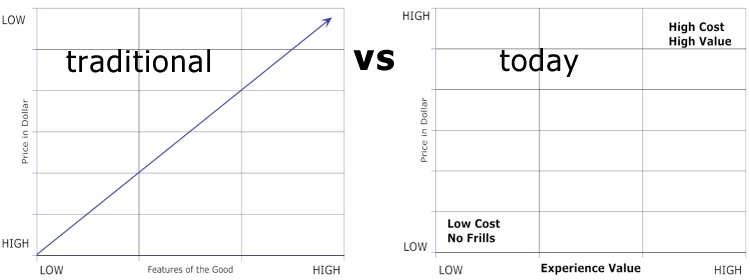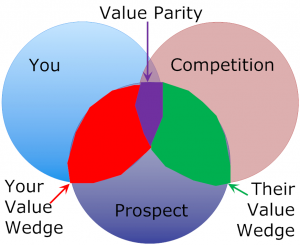
Many businesses and their sales teams are finding that they -or more importantly what they offer- are being lumped into the same basket as their competitors with customers perceiving little difference between each supplier in their respective categories. Often researching online, customers trawl through website after website comparing the latest offerings, making up their own minds about who and what they want with little or no help of the supplier companies. This perceived similarity leads to one variable becoming the main point of difference and negotiation: Price. This sameness also leads to the erosion of margins and loss of business for suppliers.
Yet, many of these supplier companies can and do have distinct points of difference that can deliver real value beyond the product itself as well as better sales results and better margins. If only these suppliers would highlight the real value they deliver beyond product and price in a compelling value proposition.
Unless a company and a salesperson have a clear and inspiring value proposition that captures the imagination of a potential buyer, chances are they are going to get the standard response and be told something like: “We’re happy with our current supplier.” Or worse, the salesperson will be ‘used’ by the customer as leverage for or against the current supplier to get what they want or need at a cheaper price.
Most sales leaders and marketing people will readily tell you that having a clear and effective value proposition is crucial to sales success.
So, what is a value proposition and where does it fit, in the sales process?
There are a few fundamentals for creating value propositions that can have a high impact, all guided by one over-arching rule – a value proposition should be written for the buyer, from their perspective, and not for the seller or supplier organisation.
That means that the value proposition should address issues that are important to the buyer, understood by and appealing to prospective customers, not sellers.
For instance, many salespeople are encountering prospects who have been downsizing, right-sizing or told to do more, with less. What does this tell you about the buyer? What is important to them? What are they looking to achieve?
When we put ourselves in the shoes of our customers and think about what they want to achieve, all of a sudden we can see how we can help them be more effective and efficient, or how we can reduce risk and thus help them be more successful with what we do. Not just with our products and services but with our experience and tacit knowledge*. Representing how we help people in a manner that is from the perspective of the buyer / customer is what a value proposition is all about.
We can prepare a value proposition at two levels:
1. Broad Value Proposition: An overarching value proposition that presents the value the company (division, etc.) intends to offer customers overall. For instance Barrett’s value proposition is:
By working with Barrett your salespeople will be able to sell better, at healthier margins with less risk. As a leader you will be able to make more informed decisions about how to lead and manage your sales team and operations.
In this value proposition we speak to both salespeople and leaders in a broader manner focusing on the core fundamentals that people in these roles are focused on.
2. Specific Value Proposition: Once we are engaged with a prospective customer in a direct selling situation and we have understood what they are wanting to achieve via effective questioning, listening and problem solving skills, we can tailor a value proposition that is unique to that customer’s situation using their language. For instance, to build a tailored value proposition start by finding out what your prospective customer is being measured on. What are they expected to achieve in the next 12 to 18 months? Maybe they have to lower supply-chain costs, or perhaps they’re expected to boost customer retention or to reduce time-to-market on new products. Whatever it is, this is the business driver for a value proposition. NB: do not confuse a Value Proposition with a Compelling Business Reason (CBR) which is for prospecting purposes.
Some guiding principles for building Value Propositions
- Every sale involves changing something even if that change is minute, so whatever is being offered to a prospect must do something faster, better, more efficiently, etc., than whatever it is going to replace. The key to making the value proposition live is to use a verb that shows movement and is based on and supports the business driver being targeted.
- As much as possible a specific value proposition should focus on the value savings or value creation in dollars. Where monetary figures aren’t appropriate or possible, percentages can be used but in all instances there needs to be a time frame to show the expected number of weeks, months or years the prospect can expect it to take, to achieve the kind of results being promised.
- The specific value proposition should not stray from the original intent of the value proposition of the company, as this is your guide, but be tailored in a language and value that your customer needs to hear for their situation.
 Businesses and salespeople who have learned to develop an effective value proposition find that their prospects become involved in the sales process, see the benefit of talking to them and taking the sales process to the next stage. And what’s more important is that prospects are usually more comfortable talking to new suppliers who appear to have something that will improve their (the buyer’s) own position and in turn prepared to pay more for the value these suppliers bring.
Businesses and salespeople who have learned to develop an effective value proposition find that their prospects become involved in the sales process, see the benefit of talking to them and taking the sales process to the next stage. And what’s more important is that prospects are usually more comfortable talking to new suppliers who appear to have something that will improve their (the buyer’s) own position and in turn prepared to pay more for the value these suppliers bring.
*Tacit knowledge: Tacit knowledge represents the ‘know-how’ in an expert’s work, but it can be difficult to articulate. It typically becomes implanted in an individual’s routines and culture of the company and thus can remain hidden. There is incredible value residing in tacit knowledge and people can pay good money to access it.
Remember everybody lives by selling something.
Author: Sue Barrett, www.barrett.com.au
Sue Barrett is the founder and CEO of the innovative and forward thinking sales advisory and education firm, Barrett and the online sales education & resource platform www.salesessentials.com. Sue was the first in Australia to get Selling a university qualification and has written more than 600 blog posts and 21 e-books on sales and with her team produces the ‘must read’ Annual 12 Sales Trends Report. Helping people and businesses sell better, Sue is a Sales Philosopher, Activist, Strategist, Speaker, Trainer and Adviser. Get to know her further on Twitter, Facebook, and Youtube.
If you valued this article, please hit the ‘like’ button and also share via your Twitter, LinkedIn, Google+ and Facebook social media platforms. You are welcome to join the conversation or ask questions so feel free to add a comment on this post.



New Article Email Notification